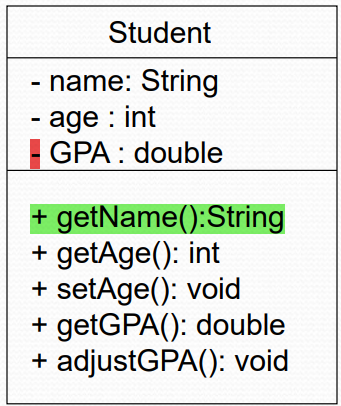Title: "[[Creating-Java-Classes]]"
Author:
- AllenYGY
status: DONE
tags:
- NOTE
- Java
- Lec3
- Program
created: 2023-11-05T00:59
updated: 2024-05-31T01:01Class and object
-
A class is a programmer-defined type.
-
A value of a class type is called an object or an instance of the class: an object exhibits the properties and behaviors defined by the object’s class.
-
Objects have data and behavior.
- Data in an object is called instance fields.
- Behaviors that operate on the data are called methods.
Class
- A class definition specifies the data items and methods that all of it subjects will have:
- Data items and methods are sometimes called members of the object.
- Data items are usually called instance fields/instance variables/attributes/properties.
UML and class diagram
- UML : pictures of an Object-Oriented system
- Programming languages are not abstract enough for OO design.
- Open standard to model the OO system.
- The most popular diagrammatic notation used for Object-Oriented Development.
- Consists of:
- Class diagrams;
- Sequence diagrams;
- Use case diagrams;
- Activity diagrams;
Diagram of one class
- Class name in the top of box
- Attributes (optional)
- Include all instance fields of the object
- visibility name : type
- Operations / methods (optional)
- visibility name (parameters) : return_type
- May omit trivial methods (get/set)
- Visibility:
- + public
- # protected
- - private
- ~ package (default)
- Underline static instance variables and static methods

Constructor 构造器
In java we use constructors to construct new instances.
- Constructors always have the same name as the class name.
- A constructoris a special kind of method that is designed to initialize the instance variables for a new object:
public ClassName(Parameters){ code }
- A constructor must have the same name as the class.
- A constructor has no type returned, not even void.
- Constructors are often overloaded. [1]
The new Operator
The new operator is used in combination with constructor to create an object from a particular class.
> ClassName classVar= new ClassName();
- The object variable refers to the newly constructed object.
In Java, the value of any object variable is a reference [2] to an object that is stored elsewhere.
Initialize
- Initialize the object variable with a newly constructed object 创建一个新的对象
- Set the variable to refer to an existing object 对存在的对象进行引用
Person person1 = new Person();
Person person2 = person1;
Person person3 = null; //refers to no object

Instance Variables
- Define:
[<modifiers>] type <fields_name> [= defaultValue] 定义在类里,方法外的变量 - In order to refer to a particular instance variable, preface it with its object name as follows:
person1.name // "." is the period operator
person2.age
- instance variables store the data of the object.
- Each object has its own copy of the variables.
- Every object has a state that is determined by the values stored in the instance variables of the object.

Local variable
A variable declared within a method definition is called a local variable. 定义在方法里的变量
- If two methods each have a local variable of the same name, they are still two entirely different variables.
- A local variable is only valid for calculation insideits method definition.
- Local variables aredestroyed automatically when the method call ends
Methods
- Define:
[<modifiers>] <return_type><name>([parameter_list]) {}
this Keyword
It(this) works as a reference to the current Object, whose method or constructor is being invoked.
this Keyword with a field
- this must be used if a parameter or a local variable with the same name is used in a method.
this Keyword with Constructor
- this keyword can be used inside the constructor to call another overloaded constructor in the same class.
- By this way, we can call the constructor explicitly.
- Note: thiskeyword can only be the first statement in Constructor
public class Person{
private intage;
private String name;
public Person(){
this("Bob",0);
System.out.println("Inside Constructor without parameter");
}
public Person(String name, intage){
this.name = name;
this.age= age;
System.out.println("Inside Constructor with two parameters");
}
}
this Keyword as a method parameter
public class Person {
private intage;
private String name;
public Person(String name, intage)
{
this.name = name;
this.age= age;
}
public void method1(Person pp)
{
System.out.println("Inside Method1");
System.out.println("Age:"+pp.age);
}
public void method2()
{
this.method1(this);
System.out.println("Inside Method2");
}
public static void main(String[] args) {
// TODO Auto-generated method stub
Person p = new Person("Bob",23);
p.method2();
}
}

Overloading 重载
- Java Method Overloading
- Overloading occurs if several methods have the same name but different parameters.
- Overloaded methods:
- appear in the same class;
- have the same name; but
- have different parameter lists; and
- can have different return types
Java access modifiers

- Only public and default can be used in the class declaration 只有public和default可以用于类名的申明
- A public class can be accessed from any place.
- A no modifier class can only be accessed from within the same package.
- protected instance variables or methods can be accessed by:
- the code of the class itself;
- subclasses;
- other code in the same package.
- private instance variables or methods can be accessed by:
- the code of the class itself;
Table Of Contents